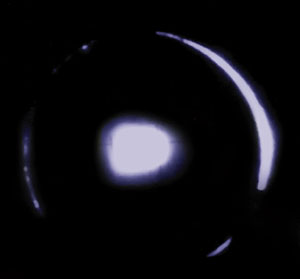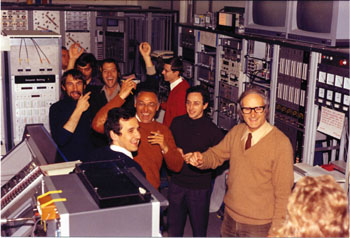This year marks the 25th anniversary of the first particle beams at the former Swiss Institute for Nuclear Research, now better known as the Paul Scherrer Institute.

In 1974 the first protons were accelerated in the ring accelerator and the first pions were produced at, what was then known as the Swiss Institute for Nuclear Research. Some 25 years later, Switzerland’s National User Laboratory for Nuclear and Particle Physics has grown into the Paul Scherrer Institute a multipurpose facility.
In the beginning
The story of the first Swiss pions started in earnest on 17 January 1974. This was a few days after protons had been successfully extracted from the 72 MeV Philips Injector Cyclotron and accelerated via a few turns to 92 MeV in the in-house-designed 590 MeV Isochronous Ring Cyclotron.
Despite vacuum problems, which meant running on only three of the four accelerating cavities, on 18 January the beam dynamics group was able to accelerate protons from 100 to 540 MeV in just 30 min. Thus it created a new world record for the rate of gain of energy achieved by an isochronous cyclotron.
Acceleration to the extraction energy of 590 MeV took a bit more effort. However, shortly before the filament of the ion source burned out, 4 nA of protons were extracted and hit an external copper beam dump. This was the first time that any accelerator had reached truly relativistic energies with a 100% macroscopic duty cycle.
The then director, Jean-Pierre Blaser, and the late Hans Willax, the designer of the ring cyclotron concept, were seen with “silent glows” on their faces. Many years of considerable effort had finally been rewarded with success.
The “big run”, which was dedicated to the production of the first pions on the external target station, started in the early afternoon of 23 February 1974. Again, difficulties were encountered, which necessitated running on only three acceleration cavities in the main ring. However, the machine crew took up the challenge, and between 0.1 and 0.2 µA of protons soon reached the extraction radius.
The highlight came just after midnight on 24 February, when the first extracted protons were seen as a bright spot on a glass scintillation screen at the thin target station. A few minutes later the eagerly waiting physicists had their moment of truth: the first pions were detected at the end of the ¼M3 channel (which was tuned for positive particles of 300 ± 3 MeV/c).
The characteristic signature of protons and pions was seen on the oscilloscope and was confirmed via pulseheight spectra from a scintillatorCherenkov counter telescope. The first results yielded some 3000 positive pions per second for a proton current of 30 nA. It was a moment for celebration.
Today, 25 years later, the main Ring Accelerator is routinely running at more than 1.5 mA (15 times as great as the design current) with an increase to 2 mA planned. With the present 1 MW proton beam power, PSI has the most intense pion and muon beams in the world. This has yielded numerous first-class results over the years. These include:
- the most precise values of the masses of the muon and the charged and neutral pion, in addition to the best “laboratory limit” on the mass of the muon neutrino;
- in the rare and forbidden decay sector, which continues to be a specialist area of research at the facility, the most precise values have been established for the branching ratios of the pion into an electron and a neutrino; and into a muon a neutrino and a photon; and a muon into three electrons and two neutrinos;
- the first observation of a pion decaying into three electrons and a neutrino, and hence the determination of the vector and the two axial-vector form factors of the pion;
- in the search for lepton-flavoured violating processes, the most sensitive limits have been achieved for a muon decaying into three electrons (less than 10-12), for muon to electron conversion in nuclei (less than 6.1 x 10-13) and for muoniumantimuonium conversion (less than 8.2 x 10-11);
- other precision measurements, one of which is the measurement of the longitudinal polarization of positrons in muon decay, which together with the results from inverse muon decay, demonstrated that the VA structure of the weak interaction follows on as a natural consequence; also, the helicity of the muon neutrino was determined for the first time;
- in the hadronic sector, the most accurate measurements of the delta (1232)** and delta (1232)0 masses and widths and the determination of the magnetic moment of the delta (1232)** have been made. Measurements in pionic hydrogen have yielded the strong interaction shift and width to unprecedented precision, from which the pionnucleon scattering lengths at threshold could be determined.
Special symposium
The anniversary was marked by a special symposium as part of the laboratory’s traditional half-yearly Accelerator Users Meeting.
The opening address was given by deputy director Ralph Eichler, who set the scene and outlined the present range of experiments at the Ring Accelerator, with the continuing trend towards larger and longer types of precision measurements.

Former director Blaser recounted the “Origins and Early Days of the Ring Cyclotron” with personal recollections and anecdotes. Then it was the turn of Claude Joseph (Lausanne), a long-standing experimenter at the facility, and Florian Scheck (Mainz), former head of the SIN Theory Group, to summarize physics milestones in the strong interaction and electroweak sectors respectively. This wealth of results is underlined by the number of corresponding entries in the Particle Data Booklet.
Finally, Jerzy Sromicki (ETHZ) gave a lively overview of the present tests of fundamental symmetries and future particle physics experiments that use neutrons from PSI’s spallation neutron source, SINQ, fed by the Ring Accelerator.
As one 25 year period closes, a new one will begin when the Swiss Light Source synchrotron radiation facility is commissioned.







